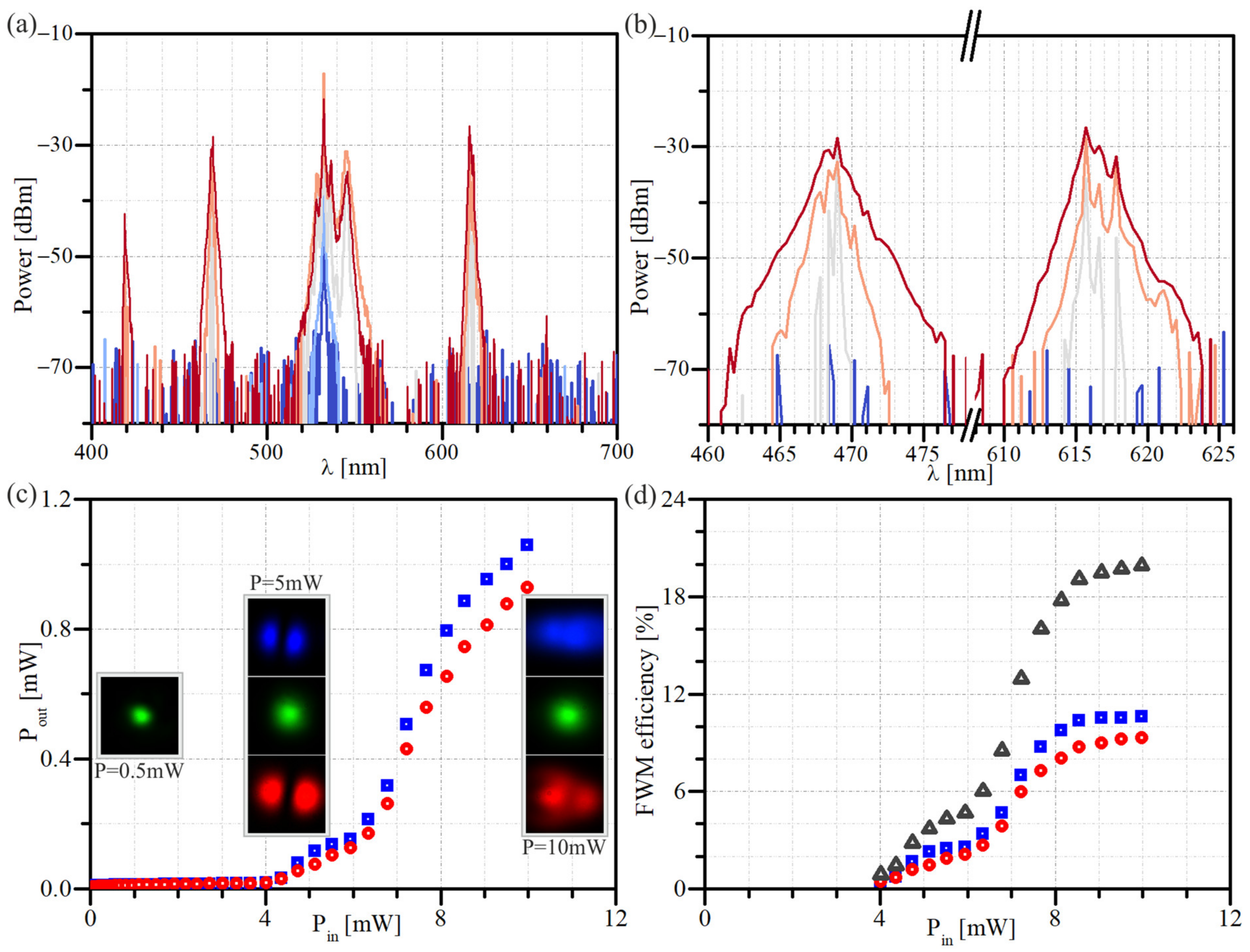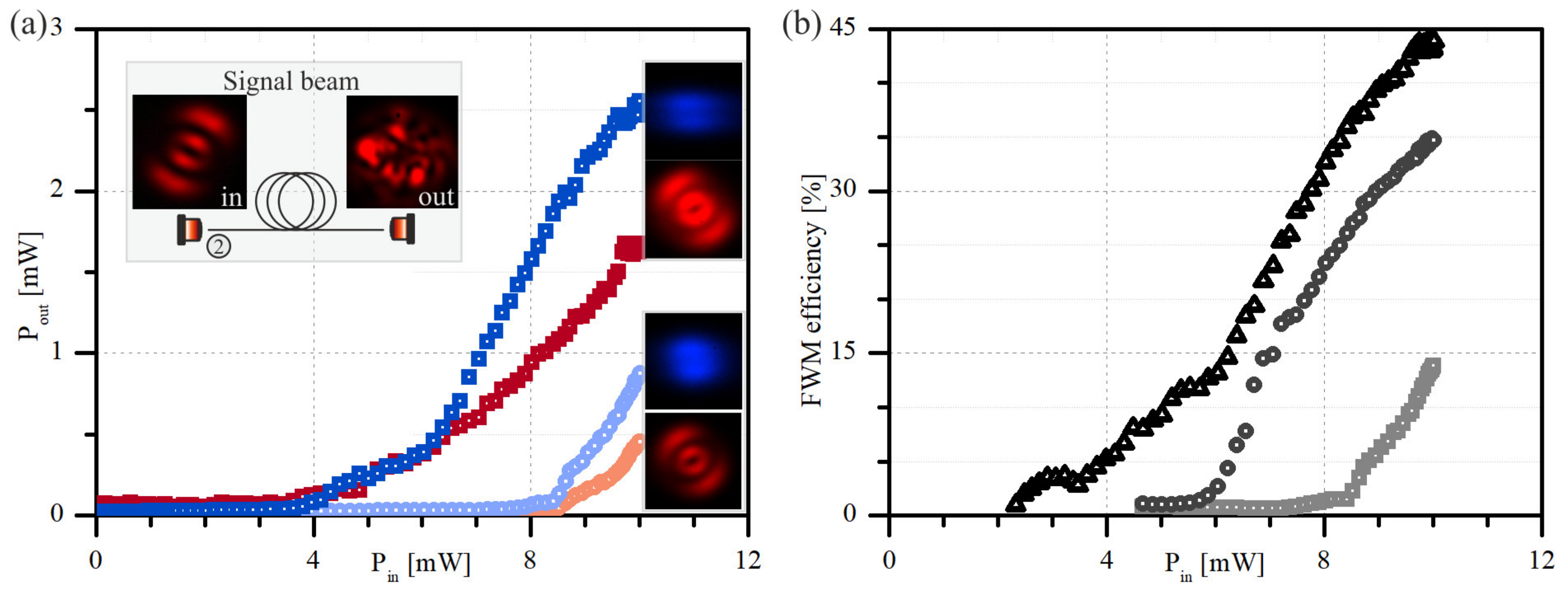An Efficient Method for the Intermodal Four-Wave Mixing Process
Abstract
:1. Introduction
2. Materials and Methods
3. Results
3.1. Single Pump Configuration
3.2. Self-Seeded Configuration
4. Perspectives
Author Contributions
Funding
Institutional Review Board Statement
Informed Consent Statement
Data Availability Statement
Conflicts of Interest
References
- Stolen, R.H.; Bjorkholm, J.E.; Ashkin, A. Phase-matched three-wave mixing in silica fiber optical waveguides. Appl. Phys. Lett. 1974, 24, 308–310. [Google Scholar] [CrossRef]
- Inoue, K.; Toba, H. Wavelength conversion experiment using fiber four-wave mixing. IEEE Photon. Technol. Lett. 1992, 4, 69–72. [Google Scholar] [CrossRef]
- Shibata, N.; Braun, R.; Waarts, R. Phase-mismatch dependence of efficiency of wave generation through four-wave mixing in a single-mode optical fiber. IEEE J. Quantum Electron. 1987, 23, 1205–1210. [Google Scholar] [CrossRef]
- Lin, C.; Bösch, M.A. Large-Stokes-shift stimulated four-photon mixing in optical fibers. Appl. Phys. Lett. 1981, 38, 479–481. [Google Scholar] [CrossRef]
- Essiambre, R.-J.; Mestre, M.A.; Ryf, R.; Gnauck, A.H.; Tkach, R.W.; Chraplyvy, A.R.; Sun, Y.; Jiang, X.; Lingle, R. Experimental Investigation of Inter-Modal Four-Wave Mixing in Few-Mode Fibers. IEEE Photon. Technol. Lett. 2013, 25, 539–542. [Google Scholar] [CrossRef]
- Parmigiani, F.; Horak, P.; Jung, Y.; Grüner-Nielsen, L.; Geisler, T.; Petropoulos, P.; Richardson, D.J. All-optical mode and wavelength converter based on parametric processes in a three-mode fiber. Opt. Express 2017, 25, 33602. [Google Scholar] [CrossRef]
- Dupiol, R.; Bendahmane, A.; Krupa, K.; Tonello, A.; Fabert, M.; Kibler, B.; Sylvestre, T.; Barthelemy, A.; Couderc, V.; Wabnitz, S.; et al. Far-detuned cascaded intermodal four-wave mixing in a multimode fiber. Opt. Lett. 2017, 42, 1293. [Google Scholar] [CrossRef] [Green Version]
- Pourbeyram, H.; Nazemosadat, E.; Mafi, A. Detailed investigation of intermodal four-wave mixing in SMF-28: Blue-red generation from green. Opt. Express 2015, 23, 14487. [Google Scholar] [CrossRef]
- Wadsworth, W.J.; Joly, N.; Knight, J.C.; Birks, T.A.; Biancalana, F.; Russell, P.S.J. Supercontinuum and four-wave mixing with Q-switched pulses in endlessly single-mode photonic crystal fibres. Opt. Express 2004, 12, 299. [Google Scholar] [CrossRef]
- Sharping, J.E. Microstructure Fiber Based Optical Parametric Oscillators. J. Lightwave Technol. 2008, 26, 2184–2191. [Google Scholar] [CrossRef]
- Lavoute, L.; Knight, J.C.; Dupriez, P.; Wadsworth, W.J. High power red and near-IR generation using four wave mixing in all integrated fibre laser systems. Opt. Express 2010, 18, 16193. [Google Scholar] [CrossRef]
- Agrawal, G. Nonlinear Fiber Optics, 5th ed.; Academic Press: Cambridge, MA, USA, 2012. [Google Scholar]
- Wong, G.K.L.; Murdoch, S.G.; Leonhardt, R.; Harvey, J.D.; Marie, V. High-conversion-efficiency widely-tunable all-fiber optical parametric oscillator. Opt. Express 2007, 15, 2947. [Google Scholar] [CrossRef]
- Xu, Y.Q.; Murdoch, S.G.; Leonhardt, R.; Harvey, J.D. Widely tunable photonic crystal fiber Fabry-Perot optical parametric oscillator. Opt. Lett. 2008, 33, 1351. [Google Scholar] [CrossRef]
- Inoue, K. Four-wave mixing in an optical fiber in the zero-dispersion wavelength region. J. Lightwave Technol. 1992, 10, 1553–1561. [Google Scholar] [CrossRef]
- Li, X.; Voss, P.L.; Sharping, J.E.; Kumar, P. Optical-Fiber Source of Polarization-Entangled Photons in the 1550 nm Telecom Band. Phys. Rev. Lett. 2005, 94, 053601. [Google Scholar] [CrossRef] [Green Version]
- Smith, B.J.; Mahou, P.; Cohen, O.; Lundeen, J.S.; Walmsley, I.A. Photon pair generation in birefringent optical fibers. Opt. Express 2009, 17, 23589. [Google Scholar] [CrossRef]
- Fang, B.; Cohen, O.; Lorenz, V.O. Polarization-entangled photon-pair generation in commercial-grade polarization-maintaining fiber. J. Opt. Soc. Am. B 2014, 31, 277. [Google Scholar] [CrossRef] [Green Version]
- Stolen, R.; Bjorkholm, J. Parametric amplification and frequency conversion in optical fibers. IEEE J. Quantum Electron. 1982, 18, 1062–1072. [Google Scholar] [CrossRef]
- Lin, Q.; Yaman, F.; Agrawal, G.P. Photon-pair generation in optical fibers through four-wave mixing: Role of Raman scattering and pump polarization. Phys. Rev. A 2007, 75, 023803. [Google Scholar] [CrossRef] [Green Version]
- Nicholson, J.W.; Yablon, A.D.; Ramachandran, S.; Ghalmi, S. Spatially and spectrally resolved imaging of modal content in large-mode-area fibers. Opt. Express 2008, 16, 7233. [Google Scholar] [CrossRef]
- Jollivet, C.; Flamm, D.; Duparre, M.; Schulzgen, A. Detailed Characterization of Optical Fibers by Combining S2 Imaging With Correlation Filter Mode Analysis. J. Lightwave Technol. 2014, 32, 1068–1074. [Google Scholar] [CrossRef]
- Stepniak, G.; Maksymiuk, L.; Siuzdak, J. Binary-Phase Spatial Light Filters for Mode-Selective Excitation of Multimode Fibers. J. Lightwave Technol. 2011, 29, 1980–1987. [Google Scholar] [CrossRef]
- Dubois, F.; Emplit, P.; Hugon, O. Selective mode excitation in graded-index multimode fiber by a computer-generated optical mask. Opt. Lett. 1994, 19, 433. [Google Scholar] [CrossRef] [PubMed]
- Friis, S.M.M.; Begleris, I.; Jung, Y.; Rottwitt, K.; Petropoulos, P.; Richardson, D.J.; Horak, P.; Parmigiani, F. Inter-modal four-wave mixing study in a two-mode fiber. Opt. Express 2016, 24, 30338. [Google Scholar] [CrossRef] [PubMed] [Green Version]
- Cholan, N.A.; Al-Mansoori, M.H.; Noor, A.S.M.; Ismail, A.; Mahdi, M.A. Self-seeded four-wave mixing cascades with low power consumption. J. Opt. 2014, 16, 105203. [Google Scholar] [CrossRef]
- Li, Y.; Hou, J.; Jiang, Z.; Leng, J.; Huang, L. Generation of broadband cascaded four-wave mixing products pumped in the anomalous dispersion regimes. J. Opt. 2014, 16, 025202. [Google Scholar] [CrossRef]





Publisher’s Note: MDPI stays neutral with regard to jurisdictional claims in published maps and institutional affiliations. |
© 2022 by the authors. Licensee MDPI, Basel, Switzerland. This article is an open access article distributed under the terms and conditions of the Creative Commons Attribution (CC BY) license (https://creativecommons.org/licenses/by/4.0/).
Share and Cite
Kwaśny, M.; Mergo, P.; Napierała, M.; Markiewicz, K.; Laudyn, U.A. An Efficient Method for the Intermodal Four-Wave Mixing Process. Materials 2022, 15, 4550. https://doi.org/10.3390/ma15134550
Kwaśny M, Mergo P, Napierała M, Markiewicz K, Laudyn UA. An Efficient Method for the Intermodal Four-Wave Mixing Process. Materials. 2022; 15(13):4550. https://doi.org/10.3390/ma15134550
Chicago/Turabian StyleKwaśny, Michał, Paweł Mergo, Marek Napierała, Krzysztof Markiewicz, and Urszula A. Laudyn. 2022. "An Efficient Method for the Intermodal Four-Wave Mixing Process" Materials 15, no. 13: 4550. https://doi.org/10.3390/ma15134550





